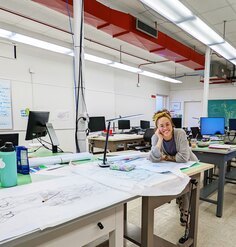Olmsted Scholar Feature: The Evolution of Wayfinding
By Colin Kreik, 2013 University Olmsted Scholar
We’ve all been caught in the situation of being lost in unfamiliar places. Excursions may be misled or forced to detour from time to time. Suddenly, recognizable routes become uncharted territories.
How do we feel at that moment? Are we lost, intimidated, flustered, or suddenly running late? Do we have tunnel vision searching for resources, knowledgeable people, or even a Hollywood sign with a big red arrow directing us where to go? Then a sigh of relief occurs, as we stumble upon a wayfinding signage display.
Found in public or private landscapes and interiors, wayfinding helps users to better understand their surroundings. These signage structures allow people to quickly digest and comprehend any given environment. While conveying proper direction can be challenging, wayfinding gives designers the ability to orchestrate navigational experiences.
Wayfinding is typically an iconic structure that combines the work of planners, graphic designers, and architects through cartography. These structures are commonly found on campuses, in airports, or along streetscapes. Over the years, wayfinding principles and techniques have evolved in conjunction with advancing environments. Trends in wayfinding are shifting from traditional graphic techniques to modern approaches that include advanced technology.
One of the most renowned wayfinding precedents is the work of Massimo Vignelli, creator of NYC’s Metropolitan Transportation Authority (MTA) subway signage and mapping. Vignelli has guided literally billions of subway riders via his largely bolded Helvetic typography and sharp colors presented with clear shapes and arrows.
F1RSTDESIGN created fascinating means of wayfinding for Zollverein Park in Essen, Germany. Their graphic design pushed wayfinding a step further by transforming a typical sitemap into a three-dimensional model. Symbols and text on the model act as a preview for signs and indicators that users will see as they travel through the industrial landscape. This approach introduces the ability for users to study and interpret a site from any given angle. The model also translates the scale of the built environment, which is often overlooked when reading two-dimensional maps.
The way that people today interact with global positioning systems (GPS) via their smartphones is one of the latest wayfinding examples. For those familiar with Google Maps and other GPS applications, who can live without this convenience?
The technological firm Control Group has patented a module to be released for future MTA passenger assistance. Soon, New Yorkers will be able to physically interact with maps in transit stations, which Gabe Stein writes is “better than paper”. NYC transit riders will have large networked touchscreen monitors at their disposal, which can display an individual guided route to the rider’s particular destination.
As the technological world advances, I believe our landscapes certainly will as well. If GPS applications have found their way into our smartphones and touchscreen kiosks can guide us in metro stations, I envision that GPS will replace today’s common wayfinding. Furthermore, I ask whether innovated wayfinding could, in turn, reshape current design methods and practices in parks, plazas, and public spaces since users will have a clearer understanding of their surroundings through new wayfinding utilities.
Colin Kreik is finishing his BLA at Boston Architectural College, where he researches methods of public mobility through wayfinding. During the year he will be re-creating wayfinding systems and navigational means for the modern landscape, which would make Ferdinand Magellan proud.











